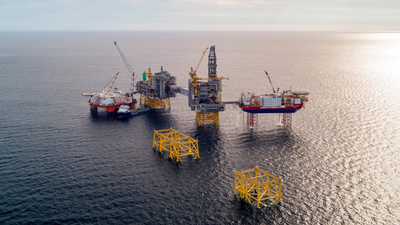Clean Ops Offshore: Johan Sverdrup Powered from Shore
With a flip of the switch, Kjell-Børge Freiberg, Norway's Minister of Petroleum and Energy, opened a new era in offshore oil and gas operations, initiating the "power-from-shore solution" that will provide the Johan Sverdrup field in the North Sea with electricity for more than 50 years.
The development is significant because with electric power supplied from shore, Johan Sverdrup operations can be run without the use of fossil fuels, making it one of the most carbon-efficient fields in the world.
The Johan Sverdrup field, which is still a year away from operation, houses an estimated 3.2 billion barrels and will have a planned a production horizon of more than 50 years. Full-field production is estimated to reach 660,000 barrels of oil per day at plateau, with a break-even of less than $20 dollars per barrel and with CO2 emissions of only 0.67 kg per barrel. Power from shore to Johan Sverdrup will help reduce emissions by an estimated 460,000 tonnes of CO2 per year.
In phase 1 of the Johan Sverdrup development the power-from-shore solution has a capacity of 100 MW, based on a production capacity of up to 440,000 barrels per day.
Several suppliers across several countries, both onshore and offshore, have been involved in developing and delivering the chosen solution for power from shore to Johan Sverdrup phase 1.
“While this is primarily known technology, the size of Johan Sverdrup increases the complexity of this. Seamless collaboration across the project has been key to the success of Johan Sverdrup so far – also as regards power from shore,” says Bokn.
ABB delivered the HVDC equipment for the two converter stations, onshore at Haugsneset close to Kårstø and offshore at the Johan Sverdrup field center. First, at Haugsneset, the electric current is converted from alternating current (AC) to direct current (DC), enabling the transmission of electricity for 200 km offshore, while minimizing loss. Then, offshore, the electric current is converted back to the alternating current needed to run the field center equipment.
Aibel was responsible for all construction related to the onshore converter station at Haugsneset. Aker Solutions (AKSO.OL) was responsible for the engineering and Samsung Heavy Industries (010140.KS) built the riser platform including the converter module where the HVDC equipment is placed offshore. And NKT was responsible for fabrication and installation of the 200 km power cables from Haugsneset out to the Johan Sverdrup field center offshore.
In Johan Sverdrup phase 2, with start-up expected in Q4 2022, the power from shore capacity will be expanded with 200 MW, giving a total capacity of 300 MW. This enables Johan Sverdrup to facilitate access to power from shore to the other fields at Utsira High – Edvard Grieg, Gina Krog og Ivar Aasen. The expanded power capacity will also be needed for the added Johan Sverdrup production capacity of 220,000 barrels per day, and the total full field production capacity of 660,000 barrels daily.

